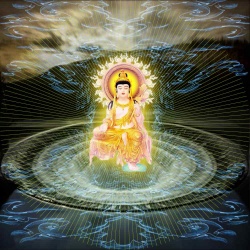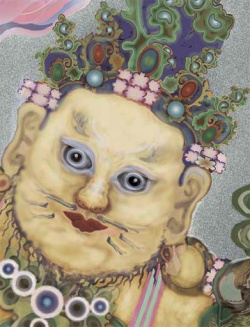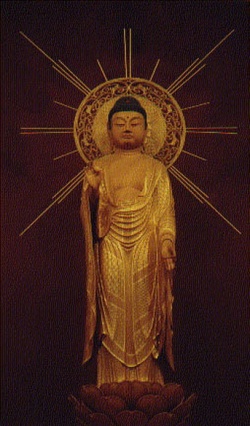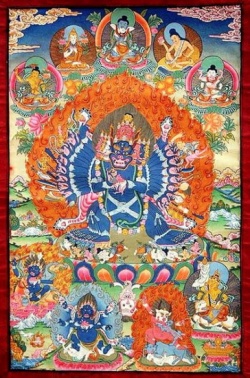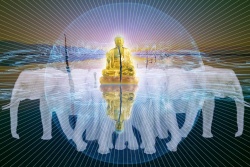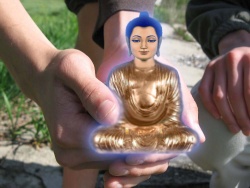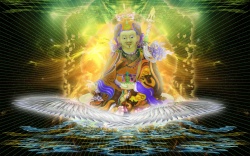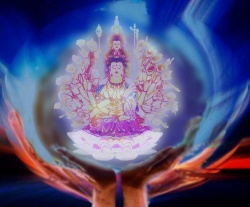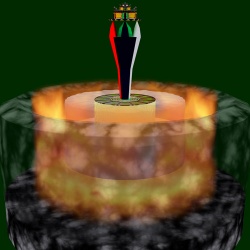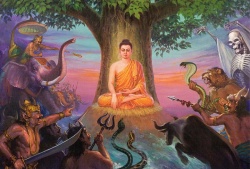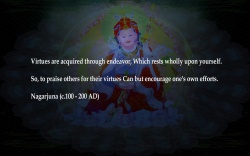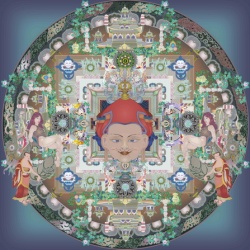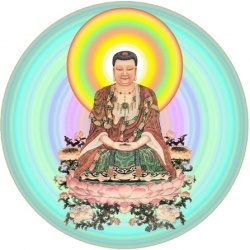Basic Features of the Gelug-Chittamatra System
Basic Features of the Gelug-Chittamatra System Alexander Berzin, May 2006
based on explanations received from Serkong Rinpoche, Geshe Dawa,Geshe Tenzin Zangpo, Gyumay Khenzur Rinpoche Losang Ngawang, and Geshe Thekchog
2 Specific Points Concerning the Three Types of Characterized Phenomena
Among forms of physical phenomena are atomic particles (rdul-phran). Although atomic particles do not exist as external phenomena; nevertheless, visible objects, such as clay vases, are made of them.
Unlike the Vaibhashika and Sautrantika assertion of atomic particles as partless (cha-med), however, Chittamatra asserts them as having directional parts.
Ways of Being Aware of Something
Ways of being aware of something include:
primary conscousnesses (rnam-shes),
subsidiary awarenesses (sems-byung, mental factors), such as feeling a level of happiness, which accompany a primary consciousness,
reflexive awareness (rang-rig).
Primary consciousnesses include the eight types of primary consciousness (rnam-shes tshogs-brgyad):
eye consciousness (mig-gi rnam-shes),
ear consciousness (rna’i rnam-shes),
nose consciousness (sna’i rnam-shes),
tongue consciousness (lce’i rnam-shes),
body consciousness (lus-kyi rnam-shes),
mind consciousness (yid-kyi rnam-shes),
deluded awareness (nyon-yid),
alayavijnana (kun-gzhi rnam-shes, all-encompassing foundation consciousness, storehouse consciousness).
Only Chittamatra Followers of Scripture assert eight types of primary consciousness.
Chittamatra Followers of Logic assert only the first six. They do not assert deluded awareness or alayavijnana.
Reflexive Awareness
Reflexive awareness accompanies every moment of any manner of cognition of an object. It itself is always nonconceptual, even when it accompanies a conceptual cognition of something.
In general, reflexive awareness focuses on, assumes the aspect of, and cognizes only the other awarenesses of the cognition – namely, the primary consciousness and subsidiary awarenesses – and the fallaciousness (]]bslu-ba\\) or nonfallaciousness (mi-bslu-ba) of them. It does not assume the aspect of or apprehend, either explicitly or implicitly, the involved objects (]]‘jug-yul\\) of the primary consciousness and subsidiary awarenesses on which it focuses.
In the case of reflexive awareness of conceptual cognitions, reflexive awareness explicitly apprehends the other awarenesses of the cognition and implicitly apprehends the categories (spyi) that are the appearing objects (snang-yul) of the cognition. The categories cognized in a conceptual cognition are not its involved objects.
An appearing object is the direct object that arises in a cognition, as if it were directly in front of the consciousness.
An involved object is a main object with which a particular cognition cognitively engages.
Although reflexive awareness cognizes the fallaciousness or nonfallaciousness of the cognitions it accompanies, it does not apprehend the fallaciousness or nonfallaciousness, either explicitly or implicitly. This is because reflexive awareness does not decisively determine whether or not the cognition it accompanies is fallacious.
Within the aspects of a cognition that are ways of being aware of something, the reflexive awareness is the cognizing aspect (‘dzin-rnam) and the other awarenesses that are its involved objects are the cognized aspect (gzung-rnam).
Reflexive awareness arises from the same natal source (rdzas) as the primary consciousness that it is aware of and is simultaneous with it. Further, it relies on the same cognitive sensors (dbang-po) as the consciousness does for its dominating condition (bdag-rkyen), for instance the photosensitive cells of the eyes.
The reflexive awareness that accompanies a cognition accounts for recollection (dran-pa, mindfulness) of that cognition. Recollection is a conceptual subsequent cognition (bcas-shes) in which a mental aspect (rnam-pa) representing the previous cognition appears and is cognized through a meaning/object category (don-spyi, meaning universal) of the previous cognition.
The subsidiary awareness “ mindfulness” (dran-pa) accompanies the conceptual subsequent cognition and acts as the “mental glue” for not forgetting or letting go of the involved object of the cognition.
Although reflexive awareness accompanies each moment of cognition, we do not necessarily recall every moment. Recollection depends on whether or not the awarenesses that the reflexive awareness accompanies apprehend their shared object, in the sense of decisively determining their object as “ this” and not “that.”
Reflexive awareness itself does not necessarily apprehend the awarenesses that are its own object. Sometimes, it is a nondetermining cognition of what appears to it (snang-la ma-nges-pa, inattentive cognition).
When the awarenesses reflexive awareness accompanies are themselves nondetermining of their shared object, the reflexive awareness is also nondetermining. In such cases, we cannot recall the awarenesses. For example, when hearing the noise of traffic in a nondetermining fashion while reading a book, the reflexive awareness that accompanies the hearing is also nondetermining. Consequently, we do not recall hearing the noise.
On the other hand, so long as the awarenesses that reflexive awareness accompany apprehend their shared involved object, then despite reflexive awareness not apprehending the fallaciousness of those awarenesses, we can still recall the awarenesses. For example, when mistakenly hearing someone say “yes” when actually he or she said “no,” so long as our hearing decisively determined – albeit, incorrectly – that what we heard was “yes,” we can recall hearing “yes.”
Alayavijnana
Alayavijnana (all-encompassing foundation consciousness, storehouse consciousness) is an individual consciousness, not a universal one.
It underlies all moments of cognition, cognizes the same objects as the cognitions it underlies, but is a nondetermining cognition of what appears to it and lacks clarity of its objects.
It is nonobstructive (ma-bsgribs) – meaning that it is not necessarily accompanied by disturbing emotions or attitudes or by unawareness about how the conventional “me” exists, and is not included among the emotional obscurations preventing liberation or the cognitive obscurations preventing omniscience.
Further, it is unspecified (lung ma-bstan) as either constructive or destructive.
It carries karmic tendencies (sa-bon, seeds), constant karmic habits (bag-chags), and the mental impressions (bag-chags, habits, instincts) of previous cognitions – what, in the West, we call “ memories.”
It “carries” them in the sense that all of these are nonstatic abstractions imputable on the alayavijnana. It doesn’t carry them in a literal sense, since none of them are forms of physical phenomena.
According to the Gelug explanation of Chittamatra as given by Tsongkhapa in his earlier writings, the continuity of the alayavijnana ceases with the true stopping of the emotional obscurations, whether this occurs with the attainment of Hinayana arhatship or an arya bodhisattva eighth level bhumi mind.
From then until Buddhahood, the ripener factor (rnam-smin cha) of the alayavijnana – the factor of alayavijnana that accounts for the ripening of aggregates from one lifetime to the next and which provides continuity – continues as a factor called “ripener consciousness” (rnam-smin-pa’i rnam-shes).
According to Tsongkhapa’s later writings on Chittamatra, the continuity of alayavijnana ceases only with the attainment of Buddhahood. In this view, ripener consciousness is a synonym for alayavijnana.
Within the Gelug tradition, the Jetsunpa textbooks accept Tsongkhapa’s later position. All the other Gelug textbooks assert his earlier position.
In either case, accompanying alayavijnana is equalizing deep awareness (mnyam-nyid ye-shes), which is involved in remembering something equal to or similar to past experiences.
With the true stopping of the cognitive obscurations, when both alayavijnana and ripener consciousness have separated out and ceased, the equalizing deep awareness functions on the fully purified level of a Buddha.
Because the alayavijnana does not continue into Buddhahood, it does not carry the enlightenment-building networks of positive force and deep awareness (collections of merit and wisdom) or other Buddha-nature factors such as the habits from listening to the Dharma (thos-pa’i bag-chags).
The basis for imputing them is the sphere of reality (chos-kyi dbyings, Skt. dharmadhatu) of the alayavijnana, its pure nature. This has continuity into Buddhahood.
Two Ways of Specifying a Person
There are two ways of specifying a person (gang-zag, individual):
We can specify an individual person (the conventional “me”) as a nonstatic abstraction imputedly knowable on the basis of the continuity of an alayavijnana.
We can also specify an individual person as the alayavijnana, since the alayavijnana is a basis having the defining characteristic mark (mtshan-gzhi) making it an individual person. It continues from one lifetime to the next, until either liberation or enlightenment, depending on the assertion of when alayavijnana ceases. In this case, a person as an alayavijnana is substantially knowable.
The conventional “me,” however, is a basis having the defining characteristic mark that delineates it only as a person.
An alayavijnana, on the other hand, is a basis having the defining characteristic marks that make it both a person and a way of being aware of something. The conventional “me” itself is never a way of being aware of something.
The technical term translated here as “nonstatic abstraction” is denmin-duchey (ldan-min ‘du-byed).
In the Sautrantika system, the term can be translated as a “ nonconcomitant affecting variable,” because nonstatic phenomena belonging to this category do not share five things in common (mtshungs-ldan lnga) with the primary consciousness and subsidiary awarenesses that they accompany.
Moreover, nonstatic phenomena in this category are neither forms of physical phenomena nor ways of being aware of something.
In the Chittamatra system, however, the technical term cannot be translated or explained in this way, since one item in this category – namely, a person or conventional “me” – can be specified as either a member of this category or as an alayavijnana.
An alayavijnana does share five things in common with the primary consciousness that it accompanies and is a way of being aware of something. For this reason, denmin-duchey is translated here as “nonstatic abstraction.”
The technical term must be translated as “nonstatic abstraction” in the Svatantrika system as well. This is because Svatantrika asserts “mental consciousness as a basis having the defining characteristic mark” (mtshan-gzhi yid-kyi rnam-shes) that also makes it an individual person.
Since Chittamatra Followers of Logic do not assert alayavijnana, they also assert mental consciousness as the basis having the defining characteristic mark that makes it also an individual person.
Deluded Awareness
Deluded awareness aims at the alayavijnana and cognizes its ripener factor as a false “me” – namely a “me” existing as a static, monolithic entity independent from its aggregates and/or existing as a self-sufficiently knowable phenomenon.
When deluded awareness focuses like this, the alayavijnana does not actually appear as its object.
Nevertheless, by the force of the alayavijnana, deluded awareness takes on a mental aspect representing a false “me” (ngar-sems-pa).
Deluded awareness is an obstructive unspecified phenomenon (bsgribs lung-ma-bstan), meaning that it is always accompanied by disturbing emotions and attitudes, and that it itself is neither destructive nor constructive.
Specifically, deluded awareness is always accompanied by unawareness (ignorance) of how the conventional “me” exists, a deluded outlook toward a transitory network (‘jig-lta), pride (nga-rgyal), and longing desire (‘dod-chags).
A deluded outlook toward a transitory network focuses on the network of one’s own five tainted aggregate factors and interpolates it to exist as the identity of a false “me” (gang-zag-gi bdag-’dzin).
Thus, deluded awareness itself does not interpolate a false “me.” It merely cognizes the mere “me” (the ripener factor of the alayavijnana) as the false “me” interpolated and projected by the accompanying deluded outlook toward a transitory network.
[See: A Deluded Outlook toward a Transitory Network.]
With the true stopping of the emotional obscurations, the continuity of deluded awareness ceases.
“Mind-Only” with Respect to the Three Types of Characterized Phenomena
One of the main emphases in the Chittamatra presentation of discriminating awareness (shes-rab, wisdom) is to realize that all phenomena are aspects of mind.
The intimate relation, however, between each of the three types of characterized phenomena and mind is different.
All the dependent phenomena in a moment of cognition share the same natal source (rdzas-gcig).
Thus, the primary consciousnesses, the subsidiary awarenesses, the reflexive awareness, the alayavijnana awareness, and the nonstatic abstractions in a moment of cognition all come from the same karmic tendency (seed) imputed on the alayavijnana.
Totally conceptional phenomena have existence established as having the essential nature (ngo-bor grub-pa) of the conceptual cognitions that take them as their cognitive objects.
Thoroughly established phenomena, as deepest truths, have the same essential nature (ngo-bo gcig) as superficial truths.
Dependent Phenomena
Concerning the first of the above three points, sharing the same natal source as the consciousness of them, this pertains only to all the dependent phenomena in a moment of cognition.
The totally conceptional and thoroughly established phenomena that are components of a cognition cannot share the same natal source as the other components do.
This is because existent totally conceptional and thoroughly established phenomena are static, nonfunctional phenomena (dngos-med); and static phenomena do not arise from causes and conditions.
The mental aspects (rnam-pa) representing nonexistent totally conceptional phenomena, such as unicorns and impossible souls, that appear in the distorted cognitions involving nonexistent phenomena are functional phenomena. These mental aspects arise from the same natal sources as the consciousnesses of them. This is not the case with the nonexistent totally conceptional phenomena themselves. The nonexistent phenomena are also nonfunctional phenomena; and so they too cannot derive from the same natal source as the consciousnesses of them.
[See: The Appearance and Cognition of Nonexistent Phenomena: Gelug Presentation.]
Nevertheless, thoroughly established and both existent and nonexistent totally conceptional phenomena do have a close relationship with the nonstatic phenomena of the cognition.
In the case of dependent and thoroughly established phenomena, let us investigate their being mind-only with an analysis of an arya’s total absorption on the four noble truths.
This is because both types of characterized phenomena have existence established as ultimate phenomena, and thus both appear to an arya’s total absorption.
All dependent phenomena are included as examples of the first noble truth, true sufferings.
This is because the five tainted aggregate factors of experience are examples of the all-pervasively affecting suffering of samsara.
In general, the aggregates are a system for classifying all nonstatic phenomena; and, specifically, the five tainted aggregates include all unpurified dependent phenomena.
Thus, during the first step of focusing on the first noble truth, an arya is focusing on all unpurified dependent phenomena, and all of them share the same natal source as the consciousness that takes them as its cognitive object.
During the first step of focusing on the second noble truth, true causes of suffering, an arya is focusing on a subclass of tainted dependent phenomena – namely, on the disturbing emotions and attitudes, and karma.
The disturbing emotions and attitudes, as well as karma, also share the same natal source as the consciousness that takes them as its cognitive object.
The fourth noble truth, true pathway minds, refers to the deep awarenesses of an arya’s total absorption and subsequent attainment.
The aggregates that accompany those deep awarenesses are untainted dependent phenomena, and they too share the same natal sources as the consciousnesses that take them as their cognitive objects.
All dependent phenomena, then, both unpurified and purified, are included in the four noble truths, and all share the same natal sources as the consciousnesses of them.
Let us leave aside, for the moment, third noble truths.
Thoroughly Established Phenomena
Both dependent phenomena and thoroghly established phenomena are ultimate phenomena.
Ultimate phenomena are those with existence established by findable individual defining characteristic marks, independently of being merely imputable by the conceptual cognitions of them.
Thoroghly established phenomena can only be imputed on ultimate phenomena.
This means that the various types of lack (in other words, the absences or voidnesses) of impossible souls are imputable only on top of individual defining characteristic marks findable on the side of the basis for imputation of these absences.
In other words, the individual defining characteristic mark on the side of the basis of imputation is the findable platform that serves as the basis for the imputation of the individual defining characteristic mark of the absences.
A findable individual defining characteristic mark can only rest on another findable individual defining characteristic mark.
If something is findable it has to be findable on the basis of something else that is findable.
Because the findable individual defining characteristic mark on the side of the dependent phenomenon is the locus for the findable individual defining characteristic mark of the thoroughly established phenomenon imputable on it, the dependent phenomenon and the thoroughly established phenomena imputable on it are said to share the same essential nature.
This means, in the Chittamatra context, that the two types of characterized phenomena share the same platform or locus for their findable individual defining characteristics.
This does not mean, however, that someone necessarily cognizes both the dependent and the thoroughly established phenomena simultaneously when focusing on the locus of the two findable characteristic marks.
The deep awareness in the total absorption of an arya’s liberated pathway mind explicitly apprehends only thoroughly established phenomena, and does not apprehend, even implicitly, the dependent phenomena that are their basis.
The deep awareness in the subsequent attainment phase of an arya’s focus on the four noble truths implicitly apprehends the thoroughly established phenomena simultaneously with explicitly apprehending the dependent phenomena that are their bases for imputation.
Only the omniscient mind of a Buddha explicitly apprehends both thoroughly established phenomena and the dependent phenomena that are their bases for imputation.
Because (1) the thoroughly established phenomena imputable on the basis of dependent phenomena share the same essential nature, and because (2) the dependent phenomena that are their basis for imputation share the same natal source as the consciousnesses of them, thoroughly established phenomena can be understood as “mind-only.”
Consider the case of an arya’s total absorption on third noble truths, true stoppings.
True stoppings are thoroughly established phenomena and are thus deepest truths. Although thoroughly established phenomena have individual defining characteristic marks that can provide a basis for the imputation of the lack of an impossible soul of phenomena with respect to true stoppings, one needs to focus first on the superficial truth of true stoppings.
True stoppings, after all, are imputably knowable and therefore valid cognition of them requires reliance on another object.
To focus on the superficial truths of third noble truths, one therefore needs to focus on the mental continuums that provide the locus for the true stoppings.
This is because ultimate phenomena (true stoppings) can only be imputed on ultimate phenomena (in this case, mental continuums).
Mental continuums are dependent phenomena and thus superficial truths. Thus, when focusing on the superficial truth of third noble truths, one focuses on the mental continuums that are their locus.
Those mental continuums are the locus, then, for not only the lack of an impossible soul of a person with respect to true stoppings, but are also the locus for the lack of an impossible soul of phenomena with respect to true stoppings.
In this respect, then, true stoppings and their lack of impossible souls both have an intimate relation with mind.
Totally Conceptional Phenomena
Totally conceptional phenomena, whether existent or nonexistent, are not included among the four noble truths.
Since they are not ultimate phenomena, we need to understand their status as mind-only outside of the context of an arya’s total absorption on the four noble truths.
The locus for totally conceptional phenomena is dependent phenomena.
In other words, dependent phenomena serve as the basis for the imputation of totally conceptional phenomena, whether existent ones or nonexistent ones.
This is so even in the case of totally conceptional phenomena, such as categories, imputable on other totally conceptional phenomena and on thoroughly established phenomena.
This is because those imputedly knowable bases for imputation must themselves be imputed on dependent phenomena as their bases for imputation.
Further, totally conceptional phenomena do not have existence established by individual defining characteristic marks findable on the sides of those totally conceptional objects, independently of these totally conceptional phenomena being merely imputable by the conceptual cognition of them.
In simpler terms, categories, for example, do not have a plastic coating around them that make them individual validly knowable objects independently of the categories being merely imputable by the conceptual cognitions of them.
If categories had a plastic coating around them that was not merely imputed, then categories could be cognized nonconceptually as individual validly knowable objects without reliance on simultaneous valid cognition of a basis for their imputation.
One could think of the category “table” without simultaneously seeing or thinking of a specific item having a flat top and supported by legs, or at least thinking of or reading the word “table.”
Moreover, the dependent phenomena that serve as the locus of totally conceptional phenomena lack the individual defining characteristic marks that can serve as foundations on which
(1) affix the sound of the words for those dependent phenomena, or on which
(2) cling the conceptual cognitions that take those dependent phenomena as their cognitive objects.
Such types of individual defining characteristic marks are not findable, already present, in the dependent phenomena, independently of those marks being merely imputable by the conceptual cognition of them.
The individual defining characteristic marks that dependent phenomena lack are of two types:
Those that concern the essential nature (ngo-bo) of a dependent phenomenon – namely, what the dependent phenomenon is, such as a “ table.”
Those that concern the attributes (khyad-par) of a dependent phenomenon – namely, its qualities such as “large,” “small,” “ beautiful,” or “ugly.”
According to Chittamatra, an object with a flat top and supported by legs has a findable individual defining characteristic mark on its own side that makes it an individual validly knowable object, independently of its being “an individual validly knowable object” being merely something imputable by a conceptual cognition of this object with a flat top and supported by legs.
In simpler terms, an object with a flat top and supported by legs has a plastic coating around it that makes it an individual validly knowable object, distinct from the air and other items around it.
That plastic coating is not merely something imputed by a conceptual cognition of this object. The plastic coating is there, on the side of the object, even when the object is nonconceptually seen.
Nevertheless, this individual validly knowable object lacks any findable individual defining characteristic marks already there on its own side that make it a “table,” or a “Tisch,” or a “ mesa,”
independently of the categories “table,” “Tisch,” or “mesa” merely being imputable by a conceptual cognition.
The same is in reference to findable individual defining characteristic marks on the side of this validly knowable object that make it “beautiful” or “ugly,” independently of the categories “beautiful” or “ugly” merely being imputable by a conceptual cognition.
Thus, the existence of the audio and meaning/object categories “table,” “Tisch,” “mesa,” “ beautiful,” or “ugly” cannot be established by individual defining characteristic marks either on the side of the categories themselves or on the side of the bases for imputation of the categories, independently of these categories being merely imputable by a conceptual cognition involving them.
In other words, the existence of these categories can only be established within the context of their being merely imputable by a conceptual cognition involving them.
Thus, as the definition of totally conceptional phenomena states, the existence of such phenomena is established in the nature of the conceptual cognitions of them.
In this sense, totally conceptional phenomena are “mind-only.”
The Absence of Dependent Phenomena Existing in the Manner of Totally Conceptional Phenomena
Of the two types of totally conceptional phenomena, existent ones have their existence established by their self-natures, as do all other validly knowable phenomena.
Their existence is established by the fact that when one searches for the actual referent “things” referred to by the names or concepts for them, those referent “things” are findable.
The referent “things” are findable on the side of the totally conceptional phenomena.
For example, when one conceptually thinks about meaning/object categories, as when trying to understand what the concept of a “ meaning/object category” refers to, the actual “thing” referred to by the name and concept “ meaning/object category” is findable on the side of meaning/object categories.
Nevertheless, as explained above, totally conceptional phenomena lack existence established by individual defining characteristic marks findable on the side of the totally conceptional phenomena, independently of the totally conceptional phenomena being merely imputable by the conceptual cognitions involving them.
In other words, the existence of categories can only be established within the context of their being imputed by a conceptual cognition involving them. Outside of that context, there is no way to establish their existence.
On the other hand, nonexistent totally conceptional phenomena, such as external existence, not only lack existence established by individual defining characteristic marks, they lack existence established by a self-nature as well.
When scrutinized with a mind scrutinizing either a superficial truth or an ultimate truth, the actual “thing” referred to by the name or concept “ external existence,” for example, cannot be found.
The voidness of dependent phenomena existing in the manner of totally conceptional phenomena is a thoroughly established phenomenon. The thoroughly established phenomenon, however, does not refer to the voidness of dependent phenomena existing in the manner of existent totally conceptional phenomena.
It is true, however, that dependent phenomena are, in fact, devoid of existence not established by individual defining characteristic marks, while totally conceptional phenomena do not have existence established by individual defining characteristic marks. However, existence not established by individual defining characteristic marks (rang-gi mtshan-nyid-kyis ma-grub-pa) is a validly knowable mode of existence.
Moreover, since existence established by individual characteristic marks is synonymous with truly established existence, then dependent phenomena have truly established existence, while totally conceptional phenomena have non-truly established existence (bden-par ma-grub-pa).
Although dependent phenomena are devoid of non-truly established existence, non-truly established existence is also a validly knowable mode of existence in the Chittamatra system.
Voidnesses that are included among thoroughly established phenomena need to be nonimplicative negation phenomena (med-dgag, nonimplicative nullifications, nonaffirming negations) in which the object to be negated (dgag-bya, object to be nullified, object to be refuted) is something totally nonexistent.
In simple terms, a nonimplicative negation phenomenon is one in which, after the sound of the words of the negation have eliminated the object to be negated, no affirmation phenomena (sgrub-pa) are left behind or implied.
The object to be negated by such a negation phenomenon may be either an existent one or a nonexistent one.
Existence not established by individual defining characteristics and non-truly established existence, as the objects to be negated, are not totally nonexistent modes of existence.
They do exist and can be validly cognized, but only in reference to existent totally conceptional phenomena.
Therefore, dependent phenomena’s voidness of these possible manners of existence is not a thoroughly established phenomenon.
The voidness of dependent phenomena existing in the manner of totally conceptional phenomenon, then, refers to their being devoid of existing in the manner of nonexistent totally conceptional phenomena.
Nonexistent totally conceptional phenomena lack existence established by self-nature.
According to Chittamatra, existence not established by self-nature (rang-bzhin-gyis ma-grub-pa) is a totally nonexistent mode of existence. It cannot be validly known, because no validly knowable phenomenon exists in that manner. It is an impossible manner of existence.
The thoroughly established phenomenon of the voidness of dependent phenomena existing in the manner of nonexistent totally conceptional phenomena, then, is a nonimplicative negation phenomenon in which the object to be negated is a nonexistent object.
Common Denominator Commonsense Objects
Dependent phenomena are the appearing objects (snang-yul) in valid nonconceptual sensory cognitions and also what appear (snang) in them.
The appearing object of a cognition is the direct object (dngos-yul) that arises in a cognition, as if it were directly in front of the consciousness (blo-ngor).
What appears in a cognition is the mental aspect (rnam-pa) that arises. It is somewhat like a mental hologram.
In valid conceptual cognition of dependent phenomena, dependent phenomena are also what appear.
The appearing objects, however, are totally conceptional phenomena, such as categories. What appears (the dependent phenomena), however, in valid conceptual cognition, is cognized through the medium of the appearing object (the category), imputed on what appears.
What appears, then, is the basis for imputation of the appearing object.
In other words, the category is the object directly in front of the mental consciousness, here; and it is described as being like a veil partially obscuring the mental hologram (the dependent phenomenon) that actually appears through the category.
As we have seen, dependent phenomena, such as an item with a flat top and supported by legs, lacks external existence.
Such an item does not come from a natal source that is different from the natal source of the consciousness and other dependent phenomena in the cognition of them.
Further, Gelug asserts that the valid nonconceptual visual cognition of the colored shape of an item with a flat top and supported by legs cognizes not only one moment of a colored shape, but also the commonsense item itself.
Both the cognized colored shape and the cognized item itself have existence established by individual defining characteristic marks, independently of their being merely imputable by the conceptual cognitions of them.
But, that existence is only established within the context of the moment of cognition that takes them as its cognitive objects.
Each time I see this commonsense item, however, a different colored shape appears in my visual cognition, depending on the angle and distance from which I see it, the lighting, and so on.
Each time I touch this commonsense object, a different tactile sensation appears (arises) in my tactile cognition.
The same is true each time I think conceptually of the item in terms of a colored shape or a tactile sensation.
The same is also the case when different persons validly see, touch, or think about the item. The colored shapes and tactile sensations that appear are always different.
The question arises, “In any particular moment, although the cognized colored shapes and tactile sensations are different, is the item itself that each sense and each person validly cognizes visually, tactilely, and mentally the same item?”
In technical terms, is there a common locus (gzhi-mthun) that is the item itself as cognized in common in all these cognitions? Is every cognitive faculty and every person cognizing the same item?
According to Tsongkhapa’s (Gelug) assertion of Chittamatra during the first part of his life, from the conventional point of view, there is a common locus commonsense item.
Everyone validly cognizing the item in any particular moment is cognizing the same item; although, from the deepest point of view, the common locus item does not exist externally as a findable referent “thing” of the cognitions.
This is because an externally existent item does not have existence established by a self-nature.
Later in his life, Tsongkhapa asserted the Chittamatra position to be that, even conventionally, no common locus item exists.
This is consistent with his assertion regarding the Prasangika-Madhyamaka view of voidness, that even from the conventionally, nothing has existence established by self-nature. Present-day Gelug follows Tsongkhapa’s later assertion regarding this point in Chittamatra.
There are no “common locus" commonsense dependent phenomena, then, that can be found, either from a conventional or a deepest point of view, as the actual referent “things” of the conceptual cognitions of them. Such common loci are nonexistent totally conceptional phenomena.
However, although commonsense dependent phenomena are devoid of existing in the nonexistent totally conceptional manner of common locus objects, nevertheless commonsense dependent phenomena do exist.
Their existence is established not only by their self-natures, but also by their individual defining characteristic marks.
Their existence is truly established as ultimate phenomena.
In other words, commonsense dependent phenomena are also devoid of existing in the manner of existent totally conceptional phenomena.
This discussion of commonsense dependent phenomena is extremely important in terms of understanding that other limited beings (sentient beings), despite being “mind-only,” actually do exist and therefore compassion for them and striving to achieve enlightenment for their sakes is appropriate. Other beings are commonsense dependent phenomena.
They do not simply exist in our heads as existent totally conceptional phenomena. They have their own karma. However, they do not exist externally.
Moreover, they do not exist as common locus beings either externally or in our heads.
Each time we see or think of some other limited being, the mental aspect of the commonsense being that appears is different. Nevertheless, the actual referent “thing” of the word or concept “commonsense being” is findable on the side of the mental aspect of the limited being that appears,
and his or her existence as a validly knowable individual object is established by a findable individual characteristic mark on the side of that mental aspect, independently of the person being merely imputable by the conceptual cognitions of him or her. Chittamatra, after all, is a Mahayana tenet system.
True and False Aspectarians
Within a particular sense field, such as the visual one, True Aspectarian Chittamatra and False Aspectarian Chittamatra differ in their explanations concerning the gross appearances (snang-ba rags-pa) that arise in valid nonconceptual sensory cognition.
A gross appearance is the appearance of something uniform, such as a blue shape.
Both divisions of Chittamatra agree that valid nonconceptual sensory cognitions of forms of physical phenomena, such as the visual cognition of a blue shape, are deceptive (‘khrul-ba) with respect to their cognition of the appearance of the blue shape as if it were an external phenomenon.
They also agree that cognition of the blue shape as a blue shape is accurate (tshul-bcas), whereas the cognition of the blue shape as a yellow shape is inaccurate (tshul-min) and distorted (log-pa).
Nevertheless,
True Aspectarian Chittamatra asserts that whatever appears grossly to valid sensory cognition is established as existing as how it appears (snang-ba ltar-du grub-pa).
False Aspectarian Chittamatra asserts that whatever appears grossly to valid sensory cognition is established as not existing as how it appears (snang-ba ltar-du ma-grub-pa).
In other words, according to the True Aspectarian view, not only does a commonsense dependent phenomenon, conventionally labeled a “blue table,” appear in the valid visual cognition of the blue shape of a flat surface supported by legs, the gross blue shape that appears in the cognition actually exists as a blue shape.
This is so, despite the blue shape being imputed on the basis of particles (pixels), each of which can be divided endlessly into parts.
According to False Aspectarian Chittamatra, commonsense dependent phenomena, such as a conventionally labeled “blue table,” do not appear in valid nonconceptual visual cognition of the blue shape of a flat surface supported by legs.
The “blue table” is a totally conceptional phenomenon, merely imputable by a conceptual cognition. The valid nonconceptual visual cognition is only of the gross blue shape.
Moreover, although the gross blue shape appears in the visual cognition and that cognition is valid; nevertheless, the gross blue shape does not actually exist in the way it appears.
Actually, the appearance of a gross blue shape is interpolated onto the appearance-making (gsal, clarity) aspect of mind, which is beyond the duality of objects and consciousnesses of them.
Even the appearance of the particles on which the gross blue shape is imputed are interpolated as well.
The True Aspectarian position, represented by Dignaga in India is harmonious with the Gelug assertions.
The False Aspectarian position, represented by the Chittamatra writings of Vasubandhu in India, accords with the non-Gelug assertion of nondenumerable ultimate phenomena (rnam-grangs ma-yin-pa’i don-dam) beyond dualities and beyond all words and concepts.
[See: Affirmations, Nullifications, and Denumerable and Nondenumerable Ultimate Phenomena.]
True Aspectarian Chittamatra has three subdivisions, the assertions of each of which are explained differently by different Tibetan masters, even with Gelug:
Proponents of an Equal Number of Cognized Objects and Cognizing Consciousnesses (gzung-’dzin grangs-mnyam-pa),
Half-Eggists (sgo-nga phyed-tshal-pa),
Proponents of Non-Dual Diversity (sna-tshogs gnyis-med-pa).
One way of describing the differences among the three is in relation to the valid visual cognition of the variegated colors on the wing of a butterfly:
Chittamatra Proponents of an Equal Number of Cognized Objects and Cognizing Consciousnesses assert that on the side of the cognized object, there are as many aspects as there are different colored shapes, and on the side of the cognizing consciousness, there are as many consciousnesses as there are cognized aspects, with each one directed at each aspect.
Chittamatra Half-Eggists assert that on the side of the cognized object, there are as many aspects as there are different colored shapes, but on the side of the cognizing consciousness, there is only one consciousness aimed at all of them.
Chittamatra Proponents of Non-Dual Diversity assert that on the side of the cognized object, there is only one aspect and that aspect contains the entire diversity of colored shapes, and on the side of the cognizing consciousness, there is only one consciousness aimed at it.
The Three Types of Lack of EssentialNature
Each of the three types of phenomena lacks an individual type of essential nature (ngo-bo-nyid med-pa).
Although the three lacks of essential nature are not thoroughly established phenomena, it is necessary to understand them in order to understand fully how everything exists:
Dependent phenomena’s lack of essential nature as something that does not arise (gzhan-dbang ma-skye ngo-bo-nyid med-pa).
Totally conceptional phenomena’s lack of an essential nature of existing with defining characteristic marks (kun-brtags mtshan-nyid ngo-bo-nyid med-pa).
Thoroughly established phenomena’s lack of an essential nature of existing as ultimate (yongs-grub don-dam-du ngo-bo-nyid med-pa).
Dependent Phenomena’s Lack of Essential Nature as Something That Does Not Arise
Dependent phenomena lack an essential nature of existing as ultimate phenomena that do not arise from causes and conditions.
Both thoroughly established and dependent phenomena are ultimate in the sense that the existence of both is established by their individual defining characteristic marks.
Therefore, the doubt may arise that they are the same types of phenomena.
This is not so. Thoroughly established phenomena (voidnesses) are static phenomena, which do not arise from causes and conditions. Dependent phenomena, on the other hand, do arise from causes and conditions.
Thus, they are devoid of being the type of ultimate phenomenon that does not arise from causes and conditions.
Totally Conceptional Phenomena’s Lack of an [[Essential [Nature]] of Existing with Defining Characteristic Marks\
Totally conceptional phenomena lack an essential nature of having existence established by individual defining characteristic marks that would make them ultimate phenomena at all.
Because totally conceptional objects lack any findable individual defining characteristic marks on their own side that establish their existence independently of being merely imputable by the conceptual cognitions of them, they do not exist in the same manner as thoroughly established and dependent phenomena do.
Thoroughly Established Phenomena's Lack of an Essentia Nature of Existing as Ultimate
Thoroughly established phenomena lack an essential nature of existing as ultimate in all senses.
The reason for this lack is because thoroughly established phenomena are devoid of being phenomena with an identity (chos-kyi bdag-med yin-tsang).
There are two ways to understand this reason, depending on how one understands the Tibetan term bdag.
The term can be taken to mean either an identity nature (bdag-nyid) or an impossible soul.
With the first meaning, the reason becomes “because thoroughly established phenomena are devoid of being phenomena with the identity nature of dependent phenomena.”
Just as dependent phenomena are not ultimate in all the senses that thoroughly established phenomena are, the same applies to thoroughly established phenomena.
Because they are devoid of having identity natures as phenomena that arise from causes and conditions, they are devoid of being the same type of ultimate phenomenon as dependent phenomena are.
Since this interpretation of this lack of an essential nature resembles the first type of lack of essential nature, this first type of lack is also called dependent phenomena’s lack of an essential nature of existing as ultimate (gzhan-dbang don-dam-du ngo-bo-nyid med-pa).
Dependent phenomena are ultimate, but they are not ultimate in all the same senses as thoroughly established phenomena are.
Although dependent phenomena, as included in the four noble truths, appear initially to an arya’s total absorption as objects to be scrutinized for existence established by an impossible soul, dependent phenomena are not the final focal point (dmigs-pa mthar-thug) at which purifier pathway minds (rnam-par dag-pa’i lam) aim as their involved objects.
A purifier pathway mind is that phase of the total absorption of an arya’s seeing or accustoming pathway mind that gets rid of a portion of obscuration.
Only thoroughly established phenomena are the final focal points of purifier pathway minds.
With the second interpretation, the reason becomes “because thoroughly established phenomena are devoid of phenomena that are impossible souls.”
Thoroughly established phenomena lack an essential nature of existing as ultimate in all senses of the word ultimate.
This is because, although thoroughly established phenomena themselves are ultimate phenomena, the objects of refutation that they are devoid of are not ultimate phenomena.
As voidnesses, thoroughly established phenomena are total absences of objects of refutation that are nonexistent totally conceptional phenomena, namely impossible souls, which are not ultimate phenomena.
Interpretable and Definitive Meanings
The Hinayana tenet systems of Vaibhashika and Sautrantika assert that all of Buddha’s teachings are to be understood literally.
The Mahayana systems, on the other hand, make a distinction between teachings of interpretable meaning (drang-don, Skt. neyartha) and of definitive meaning (nges-don, Skt. nitartha).
The former are not to be taken literally, whereas the latter may be accepted as they are.
Moreover, teachings of interpretable meaning lead one to understand teachings of definitive meaning.
Chittamatra differentiates the two types of teachings in reference to texts, whereas Prasangika-Madhyamaka differentiates them according to subject matter.
Buddha’s sutra teachings may be classified according to three rounds of transmission of the Dharma (chos-skor gsum).
According to the Gelug interpretation, Buddha taught the Hinayana teachings in the first round, primarily with the presentation of the four noble truths.
In the second round, he taught Madhyamaka, primarily with The Sutras of Far-Reaching Discrimination (Phar-phyin mdo, Skt. Prajnaparamita Sutra).
In the third round, he taught Chittamatra.
According to Chittamatra, the first and second rounds of teachings are of interpretable meaning, while the third round is definitive.
Thus, when The Prajnaparamita Sutras assert that all phenomena lack truly established existence, this is a teaching merely of interpretable meaning.
It is not to be taken literally. “Lack of truly established existence” actually means “lack of essential nature.”
Each of the three types of phenomena has its specific lack of essential nature and thus, in this sense, all phenomena lack truly established existence.
Madhyamaka asserts that the first and third rounds are interpretable, whereas the second round is definitive.
Moreover, according to Prasangika-Madhyamaka, only the prajnaparamita teachings on voidness are of definitive meaning.
Teachings on all other topics are interpretable: they lead disciples on to the understanding of voidness.
For example, when Chittamatra asserts the three types of phenomena as three different classes of phenomena, this is only of interpretable meaning.
The definitive meaning of the three types of phenomena is that they refer to different aspects of every phenomenon:
Dependent phenomena refer to every phenomenon as the basis for its voidness (stong-gzhi).
All phenomena, not merely nonstatic ones, are dependent in the sense that they dependently arise (rten-cing ‘brel-ba, Skt. pratityasamutpada) in terms of mental labeling.
Totally conceptional phenomena refer to the object to be nullified (dgag-bya, object of refutation) with respect to each phenomenon, namely its truly established existence.
Thoroughly established phenomena refer to the voidness of each phenomenon.
Further, according to Prasangika-Madhyamaka, the Chittamatra explanations of the three types of lack of essential nature are of interpretable meaning.
Their definitive meaning is that each of the three types of phenomena is devoid of an essential nature in the Prasangika sense of devoid of existence established by self-nature.
Overview of the Karma Kagyu Presentation of the Chittamatra Tenet System
The Karma Kagyu tradition, as represented by the works of the Seventh Karmapa Chodrag-gyatso (Kar-ma-pa Chos-grags rgya-mtsho) and the Eighth Karmapa Mikyo-dorjey (Kar-ma-pa Mi-bskyod rdo-rje), presents Chittamatra differently from the way the Gelug tradition does.
It agrees that a consciousness and the appearances of the phenomena that that consciousness cognizes come from the same karmic tendency on an alayavijnana.
Rather than formulating this point in terms of a cognitive object being devoid of coming from a natal source different from that of the consciousness that cognizes it, however, Karma Kagyu speaks of consciousness and the cognitive objects it cognizes as being devoid of duality (gnyis-med, nondual).
Further, Karma Kagyu has a coarse and a subtle presentation of the three types of characterized phenomena.
Coarse Presentation of the Three Types of Characterized Phenomena
According to the coarse Karma Kagyu presentation of Chittamatra, totally conceptional phenomena refer to dualistic consciousness and the objects it cognizes.
In other words, a consciousness coming from a karmic tendency and the objects it cognizes coming from their own external sources are completely imaginary. They have no true existence.
Dependent phenomena refer to the minds that cognize or experience these dualistic appearances.
They project and cognize these false appearances dependent on the power of karmic tendencies and unawareness, and thus are known as “unpurified dependent phenomena.”
They are not yet purified of karmic tendencies and the unawareness that both plants and activates these tendencies. In essence, however, these unpurified minds are minds that are devoid of projecting and cognizing these totally conceptional phenomena.
These voidnesses – the essence of unpurified minds – are thoroughly established phenomena.
They are other-voidnesses (gzhan-stong), in that they are dependent phenomena’s being devoid of something other than themselves – namely, they are devoid of totally conceptional phenomena.
Thus, one lack of an impossible soul of phenomena is dependent phenomena’s voidness of totally conceptional phenomena (gzhan-dbang kun-brtags-kyis stong-pa).
These thoroughly established other-voidnesses are truly existent levels of mind.
When all unawareness has been removed from unpurified dependent minds, the unpurified minds become “purified dependent phenomena.”
Purified dependent minds, then, are equivalent to thoroughly established phenomena and they too have true existence.
Subtle Presentation of the Three Types of Characterized Phenomena
According to Karma Kagyu, nonconceptual cognition of forms of physical phenomena, for example, have three phases. The first phase is nonconceptual sensory cognition and it cognizes only a single moment of sensibilia.
During the second phase, the nonconceptual sensory cognition is joined by nonconceptual mental cognition, also cognizing the same sensibilia.
During the third phase, the pair is joined by nonconceptual reflexive awareness cognition, which takes as its object the two cognitions that it accompanies.
Following this sequence, conceptual cognition occurs.
During the first moment, conceptual cognition imputes a commonsense object on to the sensibilia.
Up until this point, however, none of the moments of cognition make appearances of true existence or grasp at them (consider them to be true).
From the second moment of conceptual cognition onward, however, the mind imputes a category of being “this” and “not that” on to the appearance of a commonsense object.
With this labeling come appearance-making and grasping at true existence.
According to the Karma Kagyu presentation of the subtle level of Chittamatra theories, the totally conceptional phenomena are conceptual minds,
from their second moment onwards, and the appearances of truly existent external conventional commonsense objects that they cognize.
The appearances that these conceptual minds cognize are the categories that they impute or project onto moments of sensibilia. Such minds and their objects are not truly existent.
Unpurified dependent phenomena are nonconceptual sensory and mental consciousnesses and the first moment of conceptual minds, as well as the appearances of external sensibilia and commonsense objects
– but not ones that are truly existent as “this” and “not that” – that they project and cognize dependent on the power of karmic tendencies and unawareness.
Purified dependent phenomena are the nonconceptual sensory and mental consciousnesses and the first moment of conceptual minds,
as well as the appearances of nonexternal sensibilia and commonsense objects that they project and cognize when they are no longer dependent on the power of karmic tendencies and unawareness.
These are the pure appearances of Buddha-lands.
Purified dependent phenomena are dependent on the power of networks of positive force and deep awareness.
The thoroughly established phenomena are alayavijnanas themselves, as subtle continuities of consciousness that are devoid of all dependent phenomena.
In this subtle presentation as well, the thoroughly established phenomena are other-voidnesses, and, as with the coarse Chittamatra presentation, they too have true existence.
The lack of impossible soul of phenomena in this subtle presentation, then, is thoroughly established phenomena’s voidness of dependent phenomena (yongs-grub gzhan-dbang-gi stong-pa).
Superficial truths refers to totally conceptional and dependent phenomena, which lack true existence; while deepest truths are the thoroughly established phenomena, which have true existence.
Reflexive Awareness
Reflexive awareness is called, more fully, “reflexively illuminating reflexive awareness” (rang-rig rang-gsal).
It nonconceptually cognizes
(1) the awarenesses within the cognition it accompanies,
(2) the mental aspects that are the appearing objects within the cognition, and
(3) the nonduality of the two.
In any cognition, the primary consciousness and its subsidiary awarenesses are the cognizing aspect; while the mental aspect that the cognition assumes is the cognized aspect.
The primary consciousness functions as reflexively illuminating reflexive awareness, but is not equivalent to reflexively illuminating reflexive awareness.
The two have the same essential nature (ngo-bo gcig) but are different conceptually isolated items (ldog-pa tha-dad), meaning that they refer to the same aspect of the same phenomenon from two different cognitive points of view – cognition of a cognized aspect and cognition of itself.
Because nonconceptual reflexive awareness cognition occurs as the third phase of nonconceptual sensory cognition before conceptual cognition (conceptual thought) occurs, and because that reflexive awareness cognizes nonduality, Karma Kagyu emphasizes meditation practice to recognize and prolong the moment of reflexive awareness “in between thoughts.”
We can illustrate some of the major differences between the Gelug and the Karma Kagyu presentations of reflexive awareness with the following chart concerning nonconceptual sensory cognition.
